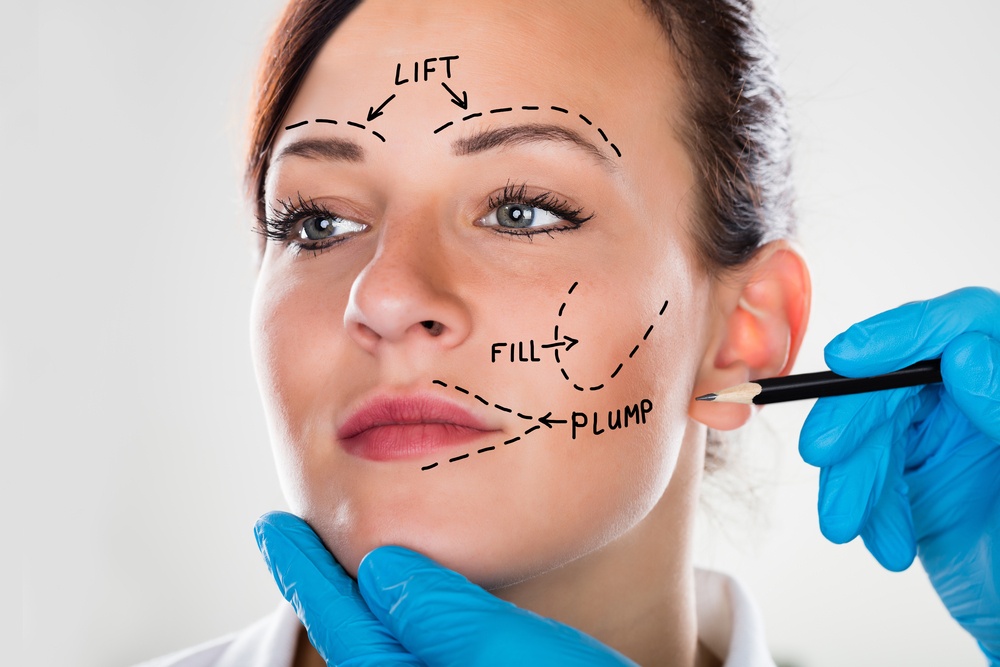You don't have to let the aging process take over your youthful appearance. In the hands of a skilled and experienced, board-certified cosmetic surgeon, like Dr. Bradford S. Patt MD, FACS, you can thwart the effects of gravity and time and bring back the natural, vibrant appearance you once had. You can also tackle early aging signs before they start taking hold of your face and skin.
What is a Facelift?
So, what is the facelift definition?
A facelift, also referred to as a rhytidectomy, is a cosmetic surgery procedure aimed at providing you with a more youthful facial appearance. The surgeon removes excess facial skin to reshape the lower half of your face.
A facelift can:
-
Tighten hanging, loose skin around your jawline,
-
Eliminate those deep creases around your nose and mouth and
-
Get rid of that excess hanging fat and skin in your neck and under your chin.
-
Tighten up underlying tissues.
Combine it with surgery to really enhance your:
-
Cheeks
-
Eyelids
-
Forehead
-
Brows
In 2016, in the U.S., 13,702 men and 107,261 women had facelift surgery. It was the fifth most popular type of aesthetic surgery among men.
Overview of What’s Involved in a Facelift Procedure
Before your procedure, the surgeon will go over your medical history. They’ll look at:
-
Blood clotting
-
Blood pressure
-
Cigarette smoking
-
Medications
-
Drug use
-
Scarring
-
Allergies
-
Skin conditions
They’ll then discuss with you what the surgery involves, the type of anesthesia they use, where the procedure takes place and any possible facelift procedure risks or complications that could develop.
They’ll likely examine the expectations and goals of the surgery, based on bone structure and skin type.
The surgeon performs a traditional facelift by making an incision at your hairline above or in your hair and in front of your temporal region (ear). They extend the incision downward in front of your ear, under your ear and then upward behind your hairline behind your ear. Then they lift the fatty tissues and skin off the fascia (connective tissue) and underlying muscle as forward as needed to correct your loose skin issue.
The surgeon can tighten the fascia and underlying muscles with sutures if they feel it's necessary. They then pull the skin upward and back and remove the excess skin. They then close the wound with skin staples and sutures.
In some cases, the surgeon will leave a drain in the wound to eliminate excess blood. They'll then apply bandages. Other surgical methods that can be done are instead of going under the fat and skin; the surgeon will go into deeper tissues. Both techniques have similar results.
Benefits of a Facelift
There are many benefits of a facelift and they continue to expand as the surgery becomes more complex and comprehensive. These days, a facelift surgery has an unprecedented ability to restore an individual's youthful appearance.
Some facelift benefits are:
Reverses the Appearance of Aging
Facelift surgery, when performed properly, can:
-
Turn back the clock
-
Smooth the skin
-
Firm up muscle tone
-
Restore an attractive facial contour
The procedure isn't designed to make you look like another person. It's designed to make you look and feel much younger.
Repairs Sagging, Loose Skin
A facelift procedure is best-known for tightening up sagging, loose skin that's begun drooping with age. As the surgeon removes these extra tissues, they can address things like:
-
Turkey wattles
-
Jowls
-
Overall aged appearance
-
Drooping skin around the eyes
While tightening is an important component of the procedure, surgeons now realize the tightening looks more natural and work the best when they restore the underlying structures of the face to a youthful configuration.
Improving Facial Contour
Unlike less sophisticated, older facelift techniques that only tighten superficial facial skin, techniques today also address the underlying facial structures — the Sub-Muscular Aponeurotic System (SMAS). Structures of the face like cheek fat sag downward as you age and your skin loses its elasticity and becomes lax.
Surgeons today first reposition the underlying facial structures into a younger configuration before they address the face's superficial layer. By doing this, it creates less skin tension and helps preserve the facelift.
Facelift Procedure Risks
Facelift surgery complications are not that frequent, and generally, cosmetic procedures are safe as long as an experienced, qualified cosmetic surgeon performs the surgery.
However, like with any procedure, there are some risks, including:
-
Bruising
-
Bleeding
-
Damage (usually temporary) to the facial nerves that control muscles
-
Numbness
-
Hematoma
-
Complications of anesthesia
-
Scarring
-
Thickening or widening of the scar
-
Loss of hair around the site of the incision (rare)
-
Infection
-
Unevenness between the two sides of your face
-
Tissue death or skin necrosis
If you notice any pain, inflammation, swelling or redness in the days following your surgery, you should seek medical attention since it can be a sign of hematoma. If you have a fever, you could have an infection.
Facelift Recovery Time
A facelift is a comprehensive and complex procedure that requires exceptional surgical skills, however, surprisingly, the recovery process is fairly quick for most individuals. Patients are usually able to get back to their normal daily activities in around two weeks, reports the American Board of Cosmetic Surgery.
You will, however, have to wait about four weeks before you engage in any strenuous exercise. Dr. Patt will provide you with detailed instructions to follow for your aftercare.
Swelling and bruising are normal after a facelift procedure and typically reach their peak around two days after the procedure. After that, the swelling and bruising get better gradually and within 10 to 14 days, you shouldn't notice them anymore.
Keep in mind, a facelift won't stop the aging process and won't change your fundamental appearance. Your skin will continue aging even though the results are permanent. Minimizing daily sunlight exposure and living a healthy lifestyle will help you maintain your facelift results.
New techniques are being developed all the time to improve cosmetic procedures. A lot of these procedures can make your recovery easier and faster.
Schedule your Facelift Consultation with Dr. Patt in Houston, Texas today
When facelift surgery is performed by a qualified and experienced cosmetic surgeon, it's a safe procedure and a great way to refresh your appearance. To really know if you'll benefit from a facelift, book a consultation with a Dr. Patt at the Houston Center for Facial Plastic Surgery.
He'll go over all the details of the facelift procedure and answer any questions you have. He’ll also let you know if you’re a good candidate for the procedure and what type of results you can expect. So, if you're interested in more information and/or are ready to undergo your facelift, schedule your facelift consultation today.



